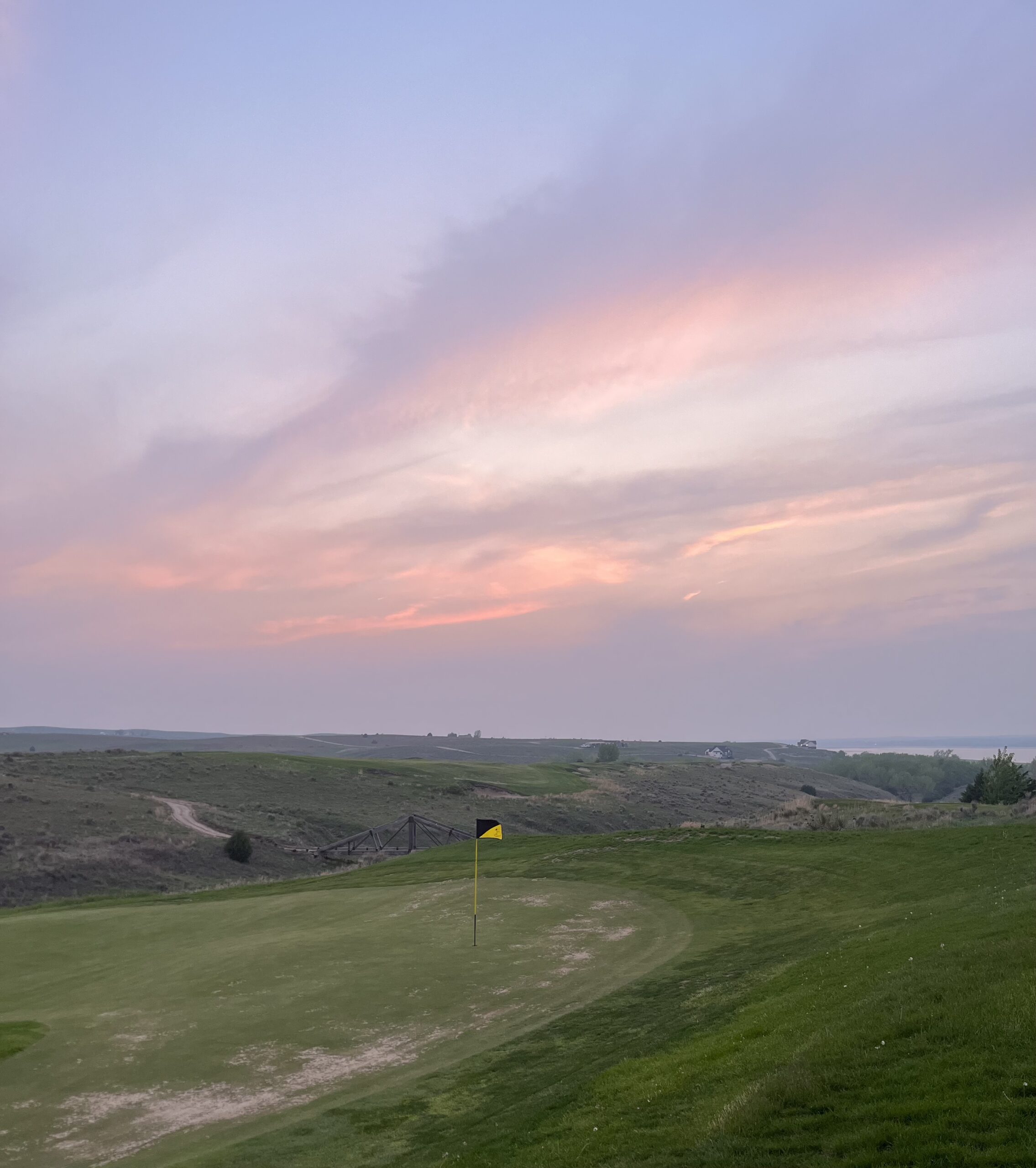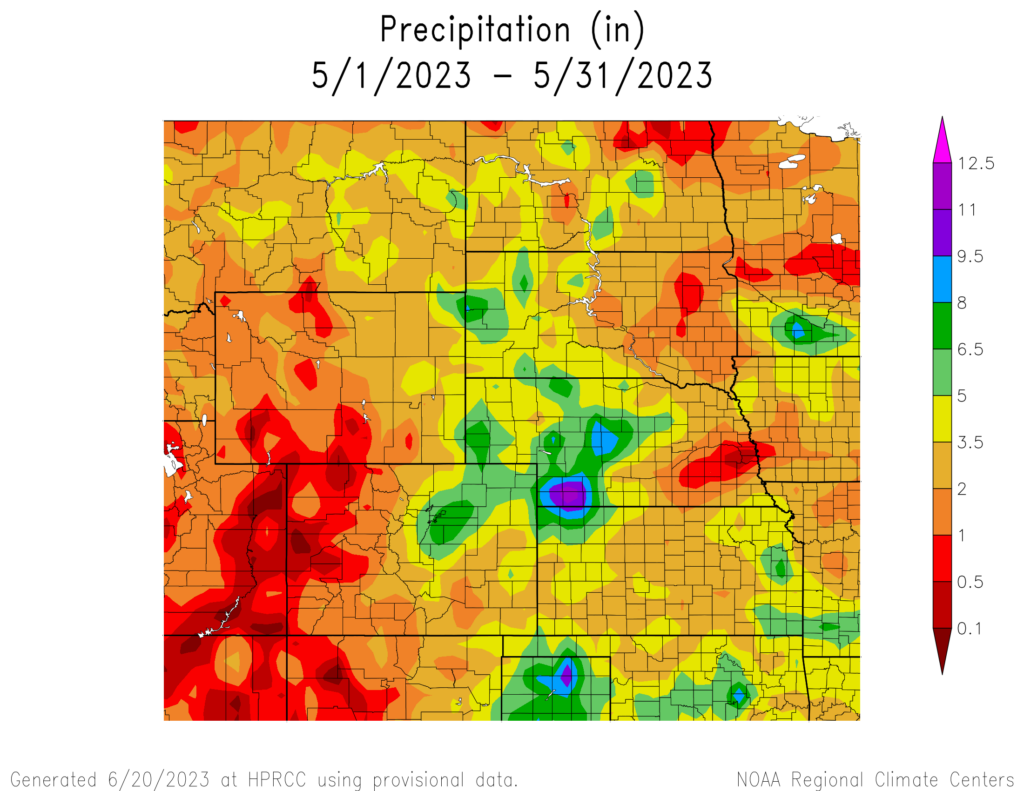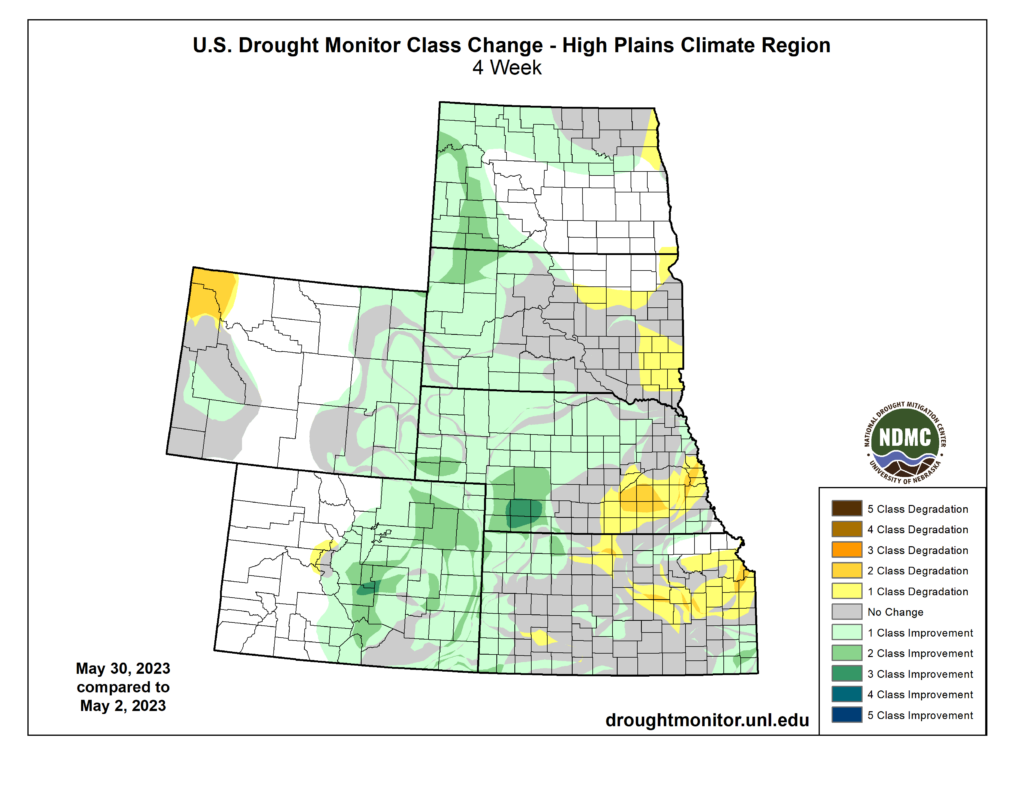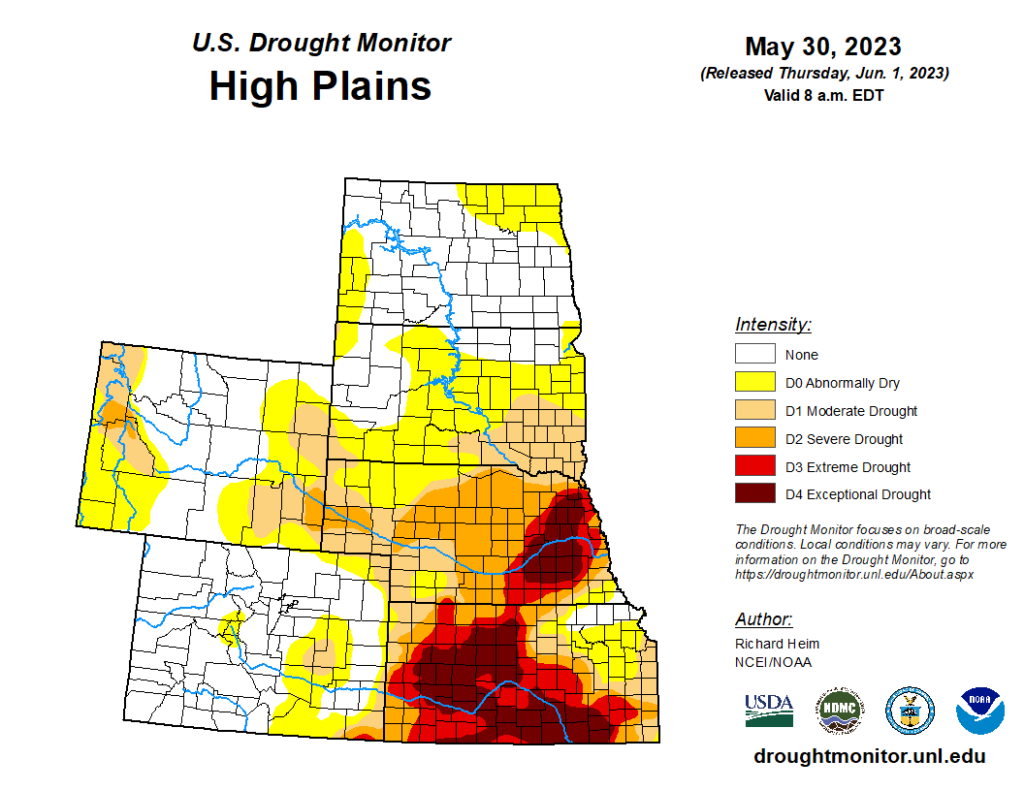
May 2023 Climate Summary
Sunset at Lake McConaughy outside of Ogallala, Nebraska, Photo Courtesy of Gannon Rush
Regional Breakdown
The phrase, “when it rains, it pours” would describe the month of May for northwestern Kansas and southwestern Nebraska. Parts of the area had gone nearly 290 days without over 0.5 inches (12.7 mm) of precipitation in a day to nearly 7.5 inches (19.05 cm) in a single day. Other places in the region like eastern Nebraska, have not been as fortunate, with near-record dryness this month and the entire spring.
The town of Culbertson in southwestern Nebraska recorded its driest year on record in 2022, with a meager 10.87 inches of precipitation (27.61 cm). In the month of May, they recorded nearly the same amount as the whole year of 2022, with 10.65 inches of precipitation (27.05 cm). While the complete reversal has greatly improved drought conditions, long-term drought impacts still plague the area. These rains are also too late to improve winter wheat yields for the year, with yields projected to be among the worst in the past 60 years.
This spring was incredibly dry across eastern Nebraska, with corn struggling to emerge. Widespread irrigation is taking place rather early in the season, due to insufficient precipitation. This dryness is not short-term, with multiple locations recording their driest past 12 months.



Precipitation and Water Resources
May precipitation was above normal for eastern Colorado, western Kansas and Nebraska, and parts of the Dakotas. The eastern part of the region was bone dry, with places 25 percent below normal.
Eastern Nebraska was dry not only this past month but the entire Spring. For the month of May, Omaha was the driest on record with only 0.17 inches (4.06 mm) of precipitation. This has broken the previous low of 0.55 inches (13.97 mm) set in 1989 and 1925 by a large margin. Lincoln was 0.02 inches (0.51 mm) from ranking driest, with only 0.51 inches this past month. Looking further back, Norfolk observed their driest spring with 2.41 inches (6.12 cm) of precipitation. Hastings and Lincoln were not far behind, ranking 3rd. The dryness plaguing the area also stretches much further back, with Hastings, Lincoln, and Norfolk all having their driest past 12 months.
A continuous onslaught of storms impacted the Front Range into the western parts of Kansas and Nebraska. McCook, Nebraska observed not only their wettest May, but also their wettest month on record with 10.94 inches (27.79 cm). Nearby CoCoRaHS observers reported amounts up to 14 inches (35.56 cm), much more than they received in 2022. Nearby North Platte ranked 3rd wettest, while Chadron ranked 5th. In Colorado, Denver ranked 4th, and Colorado Springs ranked 6th wettest.
Severe weather was active at the beginning of the month before calming down. Multiple days featured several tornadoes and 4+ inch (10.16 cm) hail, with the peak on the 12th of the month in Nebraska. 19 tornadoes were reported, with three being rated EF-2, with one having an estimated width of a mile (1.61 km). Numerous hailstone events were also reported that day. The largest hailstone with a size around 4.5 inches (11.43 cm) was reported near the town of Pawnee.
According to the United States Army Corps of Engineers, snowpack melt is nearing its conclusion. Streamflow is well below-normal across much of the eastern Plains, while conditions improved in the western portions of Kansas and Nebraska.


Temperatures
Temperatures were above-to-well above-normal for the region, with departures over 8 degrees F (4.4 degrees C) above-normal in parts of the Dakotas. Many locations ranked in the top 5 warmest after the unseasonably warm temperatures.
The Dakotas were unusually warm, with many locations observing near-record warmth this month. In North Dakota, Grand Forks and Fargo were the 2nd warmest on record while Williston and Dickinson both tied for 6th. Grand Forks surpassed 80 degrees F (26.7 degrees C) for the first time in 241 days on May 13th, marking the end of the cooler temperatures in the state. South Dakota had Sisseton, Mobridge, and Sioux Falls all rank in the top 5 warmest.
Parts of Wyoming and western Nebraska were also warmer this month, with Laramie and Cheyenne in the top 5 warmest. Portions of Yellowstone National Park reached nearly 90 degrees F (32.2 degrees C), which is their record high temperature for May. Nearby Nebraska had Chadron and Scottsbluff in the top 10 warmest this past month.
Drought Conditions
The region, for the most part, experienced improvements up to 3 classes this month thanks to constant precipitation. The areas that were dry observed up to a 2-class degradation such as eastern Nebraska and Kansas. Overall, moderate to exceptional drought (D1-D4) was reduced by 12 percent for the High Plains.
Southwestern Nebraska experienced the most improvement this month, with some areas going from extreme drought (D3) to abnormally dry (D0). The eastern part of the state observed a large increase to both D3 and D4, in response to the dryness since the beginning of the year. Elsewhere in the region, other localized improvements and degradations were observed.


Department of Agriculture (USDA), National Drought Mitigation
Center, U.S. Department of Commerce, and the National Oceanic and
Atmospheric Administration (NOAA). For current Drought Monitor
information, please see: http://droughtmonitor.unl.edu/
Climate Outlooks
According to the Climate Prediction Center, La Niña conditions have ended and transitioned to ENSO-neutral. An El Niño Watch was issued on May 11th, with conditions likely to form early this summer. For more information, visit https://www.cpc.ncep.noaa.gov/products/analysis_monitoring/lanina/enso_evolution-status-fcsts-web.pdf
The National Weather Service’s long-range flood outlook indicates increased chances of Major Flooding in central South Dakota. According to the National Interagency Fire Center (NIFC), fire potential will be limited across the region through September.
The seasonal temperature and precipitation outlook presented below combine the effects of long-term trends, soil moisture, and when applicable, the El Niño Southern Oscillation (ENSO). To learn more about these outlooks, please visit http://www.cpc.ncep.noaa.gov.
Temperature
The three-month temperature outlook shows an increased chance of above-normal temperatures across much of the United States. Increased chances of above-normal temperatures are present in Colorado, Kansas, and Wyoming.

Precipitation
The outlook for the next three months indicates below-normal precipitation across the southwestern and northwestern United States, while above-normal precipitation is favored for the central part of the country. Most of the High Plains region has chances of above-normal precipitation.

Drought
The U.S Seasonal Drought Outlook released on June 15th indicates drought conditions will likely improve.

Station Summaries: By the Number






Download PDF Below


